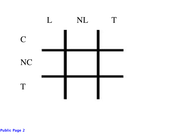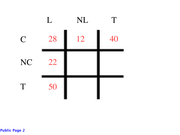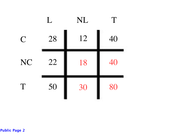At company X, 44% of the employees that own laptops do not own cellphone, and 30% of the employees that own cellphone do not own laptops. If the number of employees without laptops is 40% less than the employees with laptops, then what percent of the company's employees neither own a laptop nor a cellphone ??
A. 17.5
B. 22.5
C. 24
D. 26
E. 28
B
Overlapping Sets
This topic has expert replies
-
jose.mario.amaya
- Junior | Next Rank: 30 Posts
- Posts: 17
- Joined: Thu Nov 29, 2012 10:20 am
- Thanked: 1 times
GMAT/MBA Expert
- Brent@GMATPrepNow
- GMAT Instructor
- Posts: 16207
- Joined: Mon Dec 08, 2008 6:26 pm
- Location: Vancouver, BC
- Thanked: 5254 times
- Followed by:1268 members
- GMAT Score:770
This is a great candidate for a technique called the Double Matrix Method. It can be used for most questions featuring a population in which each member has two criteria associated with it.jose.mario.amaya wrote:At company X, 44% of the employees that own laptops do not own cellphone, and 30% of the employees that own cellphone do not own laptops. If the number of employees without laptops is 40% less than the employees with laptops, then what percent of the company's employees neither own a laptop nor a cellphone ??
A. 17.5
B. 22.5
C. 24
D. 26
E. 28
B
Here, the criteria are:
- own laptop (L) and don't own laptop (~L)
- own cellphone (C) and don't own cellphone (~C)
Since the question concerns percents only, let's say there are 100 employees in this population.
So, we get:

Aside: To learn more about this technique, watch our free video: https://www.gmatprepnow.com/module/gmat- ... ems?id=919
Let's say that x employees have laptops. This means that 100 - x employees don't have laptops. So we get:

The number of employees without laptops is 40% less than the employees with laptops.
In other words, the number of employees without laptops = 60% of the number of employees with laptops.
We can write: 100 - x = 0.6x
Simplify: 100 = 1.6x
x = 62.5
In other words, 62.5 employees have laptops.
This means that 37.5 employees don't have laptops. We get:

44% of the employees that own laptops do not own a cellphone
We now know that 62.5 employees have laptops, so 44% of 62.5 employees do not own a cellphone
44% of 62.5 = 27.5, so we get:

30% of the employees that own cellphone do not own laptops.
Let's let y = the total number of employees that own cellphone
We get:

If 30% of the employees that own a cellphone do not own laptops, then 70% of the employees that own a cellphone do own laptops.
So, 70% of y = the number of employees that own a cellphone and own a laptop.
Since we already know that 35 employees own a cellphone and own a laptop, so we can write 0.7y = 35
Solve to get y = 50
So, 50 employees own a cellphone, which means 50 employees don't own a cellphone. We get:

From here, we can fill in the remaining boxes:

Looks like 22.5 employees (out of 100 employees) own neither a laptop nor a cellphone.
Answer: B
Cheers,
Brent
--------------------------------
Once you're familiar with the Double Matrix Method, you can attempt these additional practice questions:
Easy Problem Solving questions
- https://www.beatthegmat.com/the-aam-aad ... 72242.html
- https://www.beatthegmat.com/finance-maj ... 67425.html
Medium Problem Solving questions
- https://www.beatthegmat.com/probability ... 73360.html
- https://www.beatthegmat.com/posted-spee ... 72374.html
- https://www.beatthegmat.com/motel-t271938.html
- https://www.beatthegmat.com/of-the-appl ... 70255.html
- https://www.beatthegmat.com/opening-nig ... 64869.html
- https://www.beatthegmat.com/ds-french-j ... 22297.html
Difficult Problem Solving questions
- https://www.beatthegmat.com/ratio-problem-t268339.html
- https://www.beatthegmat.com/overlapping ... 65223.html
- https://www.beatthegmat.com/fractions-t264254.html
- https://www.beatthegmat.com/overlapping ... 64092.html
- https://www.beatthegmat.com/mba/2011/05 ... question-2
Easy Data Sufficiency questions
- https://www.beatthegmat.com/for-what-pe ... 70596.html
- https://www.beatthegmat.com/ds-quest-t187706.html
Medium Data Sufficiency questions
- https://www.beatthegmat.com/sets-matrix-ds-t271914.html
- https://www.beatthegmat.com/each-of-peo ... 71375.html
- https://www.beatthegmat.com/a-manufacturer-t270331.html
- https://www.beatthegmat.com/in-costume- ... 69355.html
- https://www.beatthegmat.com/mba/2011/05 ... question-1
Difficult Data Sufficiency questions
- https://www.beatthegmat.com/double-set- ... 71423.html
- https://www.beatthegmat.com/sets-t269449.html
- https://www.beatthegmat.com/mba/2011/05 ... question-3
Last edited by Brent@GMATPrepNow on Tue Mar 25, 2014 11:45 am, edited 1 time in total.
- Atekihcan
- Master | Next Rank: 500 Posts
- Posts: 149
- Joined: Wed May 01, 2013 10:37 pm
- Thanked: 54 times
- Followed by:9 members
For two overlapping sets, total number of elements = elements only in 1st set + elements only in 2nd set + elements in both + elements in none
Assume that 100 employees own laptops.
So, 100 - 40 = 60 employees do not own laptops.
So, total number of employees = (100 + 60) = 160
Now, 44 employees own laptop but do not own cellphones.
So, 44 employees own only laptops.
So, (100 - 44) = 56 employees own both.
Now, if the number of employees who own cellphones is N, 70% of N own both laptops and cellphone.
So, 70% of N = 56
So, 30% of N = (56/7)*3 = 24
So, 24 employees own only cellphone.
So, total = only laptop + only cellphone + both + none
So, 160 = 44 + 24 + 56 + none
So, none = 160 - 124 = 36
So, required percentage = (36/160)*100 = 22.5
Answer : B
Assume that 100 employees own laptops.
So, 100 - 40 = 60 employees do not own laptops.
So, total number of employees = (100 + 60) = 160
Now, 44 employees own laptop but do not own cellphones.
So, 44 employees own only laptops.
So, (100 - 44) = 56 employees own both.
Now, if the number of employees who own cellphones is N, 70% of N own both laptops and cellphone.
So, 70% of N = 56
So, 30% of N = (56/7)*3 = 24
So, 24 employees own only cellphone.
So, total = only laptop + only cellphone + both + none
So, 160 = 44 + 24 + 56 + none
So, none = 160 - 124 = 36
So, required percentage = (36/160)*100 = 22.5
Answer : B
- GMATGuruNY
- GMAT Instructor
- Posts: 15539
- Joined: Tue May 25, 2010 12:04 pm
- Location: New York, NY
- Thanked: 13060 times
- Followed by:1906 members
- GMAT Score:790
This is an EITHER/OR problem.jose.mario.amaya wrote:At company X, 44% of the employees that own laptops do not own cellphone, and 30% of the employees that own cellphone do not own laptops. If the number of employees without laptops is 40% less than the employees with laptops, then what percent of the company's employees neither own a laptop nor a cellphone ??
A. 17.5
B. 22.5
C. 24
D. 26
E. 28
B
Every employee EITHER owns a laptop OR doesn't.
Every employee EITHER owns a cell or OR doesn't.
To organize the data, draw a GROUP GRID:

In the grid above, L = laptop, NL = no laptop, C = cell, NC = no cell.
44% of the employees who own a laptop do not own a cellphone.
Thus, 56% of laptop owners have BOTH:
.56L = LC.
30% of the employees who own a cellphone do not own a laptop.
Thus, 70% of cell owners have BOTH:
.7C = LC.
Since .56L = LC and .7C = LC, we get:
.56L = .7C
56L = 70C
4L = 5C
L/C = 5/4.
Let L = 50 and C = 40.
Since 70% of cell owners have both a laptop and a cell, LC = .7(40) = 28.
Enter these values into the grid and calculate any other values that can be determined:

The number of employees without laptops is 40% less than the employees with laptops.
Since L = 50, NL = 50 - .4(50) = 30.
Complete the grid:

Of the 80 total employees, 18 have neither a laptop nor a cell:
18/80 * 100 = 22.5%.
The correct answer is B.
Private tutor exclusively for the GMAT and GRE, with over 20 years of experience.
Followed here and elsewhere by over 1900 test-takers.
I have worked with students based in the US, Australia, Taiwan, China, Tajikistan, Kuwait, Saudi Arabia -- a long list of countries.
My students have been admitted to HBS, CBS, Tuck, Yale, Stern, Fuqua -- a long list of top programs.
As a tutor, I don't simply teach you how I would approach problems.
I unlock the best way for YOU to solve problems.
For more information, please email me (Mitch Hunt) at [email protected].
Student Review #1
Student Review #2
Student Review #3
Followed here and elsewhere by over 1900 test-takers.
I have worked with students based in the US, Australia, Taiwan, China, Tajikistan, Kuwait, Saudi Arabia -- a long list of countries.
My students have been admitted to HBS, CBS, Tuck, Yale, Stern, Fuqua -- a long list of top programs.
As a tutor, I don't simply teach you how I would approach problems.
I unlock the best way for YOU to solve problems.
For more information, please email me (Mitch Hunt) at [email protected].
Student Review #1
Student Review #2
Student Review #3
-
gmatdriller
- Master | Next Rank: 500 Posts
- Posts: 418
- Joined: Sun Jul 04, 2010 12:48 pm
- Thanked: 6 times
- Followed by:3 members
GmatGuru, your Explanations are greatly appreciated as always.
Meanwhile, from L/C = 5/4, what determines the correct values of
L and C? I put this question because different values of L and C yield
different results.
If L/C = 25 / 20 (maintaining same ratio), 0.7 of 20 gives 14
Your explanation is appreciated.
Thanks.
Meanwhile, from L/C = 5/4, what determines the correct values of
L and C? I put this question because different values of L and C yield
different results.
If L/C = 25 / 20 (maintaining same ratio), 0.7 of 20 gives 14
Your explanation is appreciated.
Thanks.




















